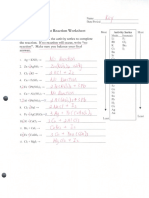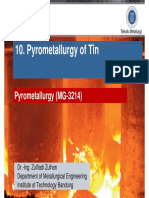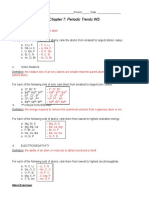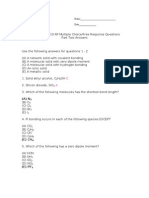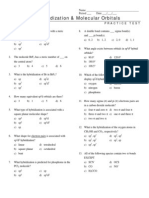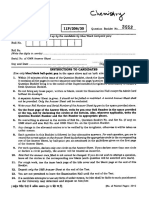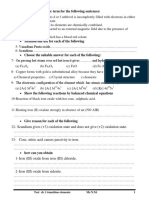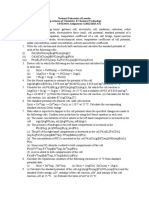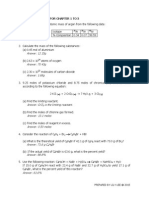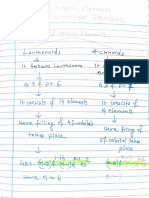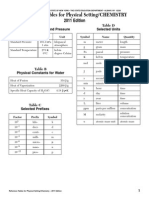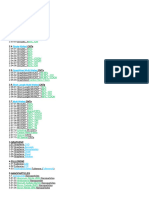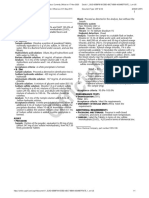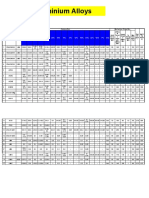Periodic Table Crystal Structure
Periodic Table Crystal Structure
Uploaded by
aramontanaCopyright:
Available Formats
Periodic Table Crystal Structure
Periodic Table Crystal Structure
Uploaded by
aramontanaOriginal Description:
Copyright
Available Formats
Share this document
Did you find this document useful?
Is this content inappropriate?
Copyright:
Available Formats
Periodic Table Crystal Structure
Periodic Table Crystal Structure
Uploaded by
aramontanaCopyright:
Available Formats
Periodic table (crystal structure)
Periodic table (crystal structure)
The thermodynamically stable structures of metallic elements adopted at standard temperature and pressure (STP)
are color-coded and shown below. The only exception is mercury, Hg, which is a liquid and the structure refers to
the low temperature form. The melting points of the metals (in K) are shown above the element symbol. Most of the
metallic elements crystallize in variations of the cubic crystal system, with the exceptions noted. "Non-metallic"
elements, like the noble gases, are not crystalline solids at STP, while others, like carbon, may have several meta
stable allotropes at STP which of course can also occur for typical metals like e.g. tin.
Table
v
t
[1]
e
Crystal structure of elements in the periodic table
H
He
453.69 1560
Li
Be
bcc hcp
Ne
370.87 923
Na
Mg
bcc hcp
933.47
Al
fcc
Si
Cl
Ar
1357.8 692.68 302.91
Cu
Zn
Ga
fcc
hcp
Ge
As
Se
Br
Kr
505
Sn
904
Sb
Te
Xe
At
Rn
336.53 1115 1814 1941 2183 2180 1519 1811 1768 1728
K
Ca
Sc
Ti
V
Cr
Mn
Fe
Co
Ni
bcc
fcc hcp hcp bcc
bcc
bcc hcp
fcc
312.46 1050 1799 2128 2750 2896 2430 2607 2237 1828
Rb
Sr
Y
Zr
Nb
Mo
Tc
Ru
Rh
Pd
bcc
fcc hcp hcp bcc
bcc
hcp hcp fcc
fcc
301.59 1000
Cs
Ba
bcc bcc
Fr
973
Ra
bcc
1235
Ag
fcc
594
Cd
2506 3290 3695 3459 3306 2719 2041.4 1337.33 234.32
Hf
Ta
W
Re
Os
Ir
Pt
Au
Hg
hcp bcc
bcc
hcp hcp fcc
fcc
fcc
Rf
Db
Sg
Bh
Hs
Mt
Ds
430
In
577
Tl
hcp
600.61 544.7 527
Pb
Bi
Po
fcc
Rg
Cn
Uut
Fl
1193 1068 1208 1297 1315 1345 1099 1585
La
Ce
Pr
Nd
Pm Sm
Eu
Gd
dhcp fcc dhcp dhcp dhcp
bcc
hcp
1629
Tb
hcp
1680
Dy
hcp
1734
Ho
hcp
1802
Er
hcp
1323 2115 1841 1405.3 917 912.5 1449 1613
Ac Th
Pa
U
Np
Pu Am
Cm
fcc fcc
dhcp dhcp
1323
Bk
dhcp
1173
Cf
dhcp
1133
Es
fcc
Fm
Uup
Lv
Uus Uuo
1818 1097 1925
Tm Yb Lu
hcp fcc hcp
Md
No
Lr
Periodic table (crystal structure)
Legend:
The top number in the cell is the melting point (in K)
bcc: body centered cubic
fcc: face centered cubic (cubic close packed)
hcp: hexagonal close packed
dhcp: double hexagonal close packed
unusual structure
nonmetal
unknown or uncertain
Unusual structures
Element
crystal
system
coordination number
notes
Mn
cubic
distorted bcc unit cell contains Mn atoms in 4 different
environments
Zn
hexagonal
distorted from ideal hcp. 6 nearest neighbors in same plane- 6
in adjacent planes 14% farther away
Ga
orthorhombic
each Ga atom has one nearest neighbour at 244 pm, 2 at 270
pm, 2 at 273 pm, 2 at 279 pm.
Cd
hexagonal
distorted from ideal hcp. 6 nearest neighbours in the same
plane- 6 in adjacent planes 15% farther away
In
tetragonal
slightly distorted fcc structure
Sn
tetragonal
4 neighbours at 302 pm; 2 at 318 pm; 4 at 377 pm; 8 at 441
pm
Sb
rhombohedral puckered sheet; each Sb atom has 3 neighbours in the same
sheet at 290.8pm; 3 in adjacent sheet at 335.5 pm.
grey metallic form.
Hg
rhombohedral 6 nearest neighbours at 234 K and 1 atm (it is liquid at room
temperature and thus has no crystal structure at ambient
conditions!)
this structure can be considered to be a distorted hcp
lattice with the nearest neighbours in the same plane
being approx 16% farther away
Bi
rhombohedral puckered sheet; each Bi atom has 3 neighbours in the same
sheet at 307.2 pm; 3 in adjacent sheet at 352.9 pm.
Bi, Sb and grey As have the same space group in their
crystal
Po
cubic
6 nearest neighbours
simple cubic lattice. The atoms in the unit cell are at the
corner of a cube.
Sm
trigonal
12 nearest neighbours
complex hcp with 9 layer repeat, ABCBCACAB....
Pa
tetragonal
body centred tetragonal unit cell, which can be considered to
be a distorted bcc
The structure is related to Iodine.
white tin form (thermodynamical stable above 286.4 K)
[2]
Periodic table (crystal structure)
orthorhombic
strongly distorted hcp structure. Each atom has four near
neighbours, 2 at 275.4 pm, 2 at 285.4 pm. The next four at
[3]
distances 326.3 pm and four more at 334.2 pm.
Np
orthorhombic
highly distorted bcc structure. Lattice parameters: a=666.3
[4][5]
pm, b=472.3 pm, c=488.7 pm
Pu
monoclinic
slightly distorted hexagonal structure. 16 atoms per unit cell.
Lattice parameters: a= 618.3 pm, b=482.2 pm, c=1096.3 pm,
[6][7]
= 101.79
Usual crystal structures
Close packed metal structures
Many metals adopt close packed structures i.e. hexagonal close packed and face centred cubic structures (cubic close
packed). A simple model for both of these is to assume that the metal atoms are spherical and are packed together in
the most efficient way (close packing or closest packing). In closest packing every atom has 12 equidistant nearest
neighbours, and therefore a coordination number of 12. If the close packed structures are considered as being built of
layers of spheres then the difference between hexagonal close packing and face centred cubic each layer is
positioned relative to others. Whilst there are many ways can be envisaged for a regular build up of layers:
hexagonal close packing has alternate layers positioned directly above/below each other, A,B,A,B, ......... (also
termed P63/mmc, Pearson symbol hP2, strukturbericht A3) .
face centered cubic has every third layer directly above/below each other,A,B,C,A,B,C,.......(also termed cubic
close packing, Fm3m, Pearson symbol cF4, strukturbericht A1) .
double hexagonal close packing has layers directly above/below each other, A,B,A,C,A,B,A,C,.... of period length
4 like an alternative mixture of fcc and hcp packing (also termed P63/mmc, Pearson Symbol hP4, strukturbericht
A3' ).[8]
-Sm packing has a period of 9 layers A,B,A,B,C,B,C,A,C,.... (R3m, Pearson Symbol hR3, strukturbericht
C19).[9]
Hexagonal close packed
In the ideal hcp structure the unit cell axial ratio is
~ 1.633, However there are deviations from this in some
metals where the unit cell is distorted in one direction but the structure still retains the hcp space groupremarkable
all the elements have a ratio of lattice parameters c/a < 1.633 (best are Mg and Co and worst Be with c/a ~ 1.568). In
others like Zn and Cd the deviations from the ideal change the symmetry of the structure and these have a lattice
parameter ratio c/a > 1.85.
Periodic table (crystal structure)
Face centered cubic (cubic close packed)
More content relating to number of planes within structure and implications for glide/slide e.g. ductility.
Double hexagonal close packed
Similar as the ideal hcp structure, the perfect dhcp structure should hava a lattice parameter ratio of
3.267. In real dhcp structures of the 5 lanthanides (including -Ce)
variates between 1.596 (Pm) and 1.6128 (Nd).
For the 4 known actinides dhcp lattices the corresponding number variate between 1.620 (Bk) and 1.625 (Cf).[10]
Body centred cubic
This is not a close packed structure. In this each metal atom is at the centre of a cube with 8 nearest neighbors,
however the 6 atoms at the centres of the adjacent cubes are only approximately 15% further away so the
coordination number can therefore be considered to be 14 when these are included. Note that if the body centered
cubic unit cell is compressed along one 4 fold axis the structure becomes face centred cubic (cubic close packed).
Trends in melting point
Melting points are chosen as a simple, albeit crude, measure of the stability or strength of the metallic lattice. Some
simple trends can be noted. Firstly the transition metals have generally higher melting points than the others. In the
alkali metals (group 1) and alkaline earth metals (group 2) the melting point decreases as atomic number increases,
but in transition metal groups with incomplete d-orbital subshells, the heavier elements have higher melting points.
For a given period, the melting points reach a maximum at around group 6 and then fall with increasing atomic
number.
References
[1] http:/ / en. wikipedia. org/ w/ index. php?title=Template:Periodic_table_(crystal_structure)& action=edit
[2] A.F Wells (1962) Structural Inorganic Chemistry 3d Edition Oxford University Press
[3] Harry L. Yakel, A REVIEW OF X-RAY DIFFRACTION STUDIES IN URANIUM ALLOYS. The Physical Metallurgy of Uranium Alloys
Conference, Vail, Colorado, Feb. 1974
[4] Lemire,R.J. et al.,Chemical Thermodynamics of Neptunium and Plutonium, Elsevier, Amsterdam, 2001
[5] URL http:/ / cst-www. nrl. navy. mil/ lattice/ struk/ a_c. html
[6] Lemire,R.J. et al.,2001
[7] URL http:/ / cst-www. nrl. navy. mil/ lattice/ struk/ aPu. html
[8] URL http:/ / cst-www. nrl. navy. mil/ lattice/ struk/ a3p. html
[9] URL http:/ / cst-www. nrl. navy. mil/ lattice/ struk/ c19. html
[10] Nevill Gonalez Swacki & Teresa Swacka, Basic elements of Crystallography, Pan Standford Publishing Pte. Ltd., 2010
General
Actinides and the Environment, Edited by P.A. Sterne, A. Gonis and A.A. Borovoi, NATO ASI Series, Proc. of the
NATO Advanced Study Institute on Actinides and the Environment, Maleme, Crete, Greece, July 1996, Kluver
Academic Publishers,. p.pp.5961. ISBN0-7923-4968-7.
The Chemistry of the Actinide and Transactinide Elements, Edited by L.R. Morss, Norman M. Edelstein, Jean
Fuger, 3rd. Edition, Springer 2007 ISBN 1402035551. ISBN978-1402035555.
Periodic table (crystal structure)
External links
Strukturbericht Type A structure reports for the pure elements (http://cst-www.nrl.navy.mil/lattice/struk/
atype.html)
Crystal Structures for the solid chemical elements at 1 bar (http://wwwhomes.uni-bielefeld.de/achim/
ele_structures.html)
Article Sources and Contributors
Article Sources and Contributors
Periodic table (crystal structure) Source: http://en.wikipedia.org/w/index.php?oldid=595779889 Contributors: Axiosaurus, Benjah-bmm27, Chris the speller, DePiep, Double sharp,
Headbomb, Icairns, Khazar2, Lfh, LilHelpa, Magioladitis, Morning277, Nergaal, OlEnglish, Raistuumum, Rjwilmsi, Savantas83, StringTheory11, Suchit Verma, Swpb, Wham Bam Rock II,
Widefox, 71 anonymous edits
Image Sources, Licenses and Contributors
File:Asterisks one.svg Source: http://en.wikipedia.org/w/index.php?title=File:Asterisks_one.svg License: Creative Commons Attribution-Sharealike 3.0 Contributors: User:DePiep
File:Asterisks two.svg Source: http://en.wikipedia.org/w/index.php?title=File:Asterisks_two.svg License: Creative Commons Attribution-Sharealike 3.0 Contributors: User:DePiep
File:Asterisks one (right).svg Source: http://en.wikipedia.org/w/index.php?title=File:Asterisks_one_(right).svg License: Creative Commons Attribution-Sharealike 3.0 Contributors:
User:DePiep
File:Cubic-body-centered.svg Source: http://en.wikipedia.org/w/index.php?title=File:Cubic-body-centered.svg License: GNU Free Documentation License Contributors: Original PNGs by
Daniel Mayer, DrBob, traced in Inkscape by User:Stannered
File:Cubic-face-centered.svg Source: http://en.wikipedia.org/w/index.php?title=File:Cubic-face-centered.svg License: GNU Free Documentation License Contributors: Original PNGs by
Daniel Mayer and DrBob, traced in Inkscape by User:Stannered
File:Hexagonal close packed.svg Source: http://en.wikipedia.org/w/index.php?title=File:Hexagonal_close_packed.svg License: Creative Commons Attribution-Sharealike 3.0 Contributors:
DePiep, Torsch
File:Hexagonal.svg Source: http://en.wikipedia.org/w/index.php?title=File:Hexagonal.svg License: BSD Contributors: Original uploader was Danieljamesscott at en.wikipedia
License
Creative Commons Attribution-Share Alike 3.0
//creativecommons.org/licenses/by-sa/3.0/
You might also like
- Biochemistry Concept MapDocument1 pageBiochemistry Concept MapDavid Harris0% (1)
- Sample Problems For Test 4 ThermochemistryDocument6 pagesSample Problems For Test 4 ThermochemistrySuraj KarkiNo ratings yet
- PMR Spectroscopy: Solved Problems Volume : IIFrom EverandPMR Spectroscopy: Solved Problems Volume : IIRating: 5 out of 5 stars5/5 (3)
- Single Replacement Reaction Worksheet KeyDocument1 pageSingle Replacement Reaction Worksheet KeyTricia Dionela100% (1)
- Minerals and Metals in Ancient IndiaDocument2 pagesMinerals and Metals in Ancient IndiaSuneel KotteNo ratings yet
- Pyrometallurgy - Tin, Rev 1 PDFDocument44 pagesPyrometallurgy - Tin, Rev 1 PDFDimas Aditya100% (3)
- Symmetry Point Groups and Character TablDocument32 pagesSymmetry Point Groups and Character TablKishore Kishore100% (1)
- Open Stax Chem 2e Answer With Explanation 1Document1 pageOpen Stax Chem 2e Answer With Explanation 1siewyonglimNo ratings yet
- CHEMISTRY XII Model Test PaperDocument68 pagesCHEMISTRY XII Model Test PaperAman KumarNo ratings yet
- Chapter 1. L1. Structure & BondingDocument35 pagesChapter 1. L1. Structure & BondingMohammad Al-KhoderNo ratings yet
- Tables For Group TheoryDocument39 pagesTables For Group TheoryChattawat ThangsrikeattigunNo ratings yet
- Answers 7Document22 pagesAnswers 7SureshkumaryadavNo ratings yet
- LS - 0 - 2 - 2d3125 - 0246d18b52c60-Group TheoryDocument2 pagesLS - 0 - 2 - 2d3125 - 0246d18b52c60-Group TheoryHamit RanaNo ratings yet
- Chapter 7: Periodic Trends WS: More ExercisesDocument2 pagesChapter 7: Periodic Trends WS: More ExercisesDemetrius OmarNo ratings yet
- D and F BlockDocument15 pagesD and F Blockthinkiit100% (1)
- P Block Elements in PPT FormDocument138 pagesP Block Elements in PPT FormharshadNo ratings yet
- Chapter 6 TestDocument5 pagesChapter 6 TesthelloblargNo ratings yet
- OrganicChemistryChapter5 PDFDocument19 pagesOrganicChemistryChapter5 PDFJuliet Tatiana CumbeNo ratings yet
- Symmetry N Group TheoryDocument12 pagesSymmetry N Group Theorysanguine_shamiNo ratings yet
- Lecture 1 OrganometallicsDocument19 pagesLecture 1 OrganometallicsA JNo ratings yet
- Module 1 - Electrochemical EnergyDocument129 pagesModule 1 - Electrochemical EnergyknightruzelNo ratings yet
- Solid StateDocument13 pagesSolid StatesachinkurhekarNo ratings yet
- H2 Atomic Structure, Stiochiometry QuestionsDocument8 pagesH2 Atomic Structure, Stiochiometry QuestionskitoniumNo ratings yet
- Organic Problems Form Five/Six: ALLAI-ACADEMY-ORGANIC PROBLEMS FOR DEC.2019-BY MR MANDIA 0689154703/0757983103Document5 pagesOrganic Problems Form Five/Six: ALLAI-ACADEMY-ORGANIC PROBLEMS FOR DEC.2019-BY MR MANDIA 0689154703/0757983103Yøüñg BøëNo ratings yet
- 1 - Electric Charges & FieldDocument16 pages1 - Electric Charges & FieldAawesh BackupsNo ratings yet
- CH 9 and 10 AP Part 2 AnswersDocument7 pagesCH 9 and 10 AP Part 2 AnswersjohntheuglyllamaNo ratings yet
- CHAPTER 3 StereochemistryDocument39 pagesCHAPTER 3 StereochemistrysyamimiafrinaNo ratings yet
- 10 Orbital Hybridization & Molecular OrbitalsDocument2 pages10 Orbital Hybridization & Molecular Orbitalserice12No ratings yet
- 10 Chapter Electrochemistry Text Book ExerciseDocument31 pages10 Chapter Electrochemistry Text Book ExerciseSajid AzeemNo ratings yet
- BHU M.SC Chemistry Entrance Exam PaperDocument32 pagesBHU M.SC Chemistry Entrance Exam Paperutkarsh130896No ratings yet
- Molecular Orbital TheoryDocument28 pagesMolecular Orbital TheoryMuhammad Anas BilalNo ratings yet
- AP Chapter 13 MC Practice Questions With MC AnswersDocument9 pagesAP Chapter 13 MC Practice Questions With MC AnswersapantollanoNo ratings yet
- Unit - 8 AtomsDocument9 pagesUnit - 8 AtomsSahil Chawla100% (1)
- Isolobal AnalogyDocument4 pagesIsolobal Analogyindu priyaNo ratings yet
- D and F Block Elements 2Document9 pagesD and F Block Elements 2Dr. P.S.SenguptaNo ratings yet
- (3335) DPP 17 Chemical Bonding BDocument2 pages(3335) DPP 17 Chemical Bonding BRAJDEEP DASNo ratings yet
- Chemistry Final Exam 1 - 2012Document11 pagesChemistry Final Exam 1 - 2012Alex HwangNo ratings yet
- Chapter 06 Phase Equilibria 4 PDF FreeDocument77 pagesChapter 06 Phase Equilibria 4 PDF FreeGabriel SilvaNo ratings yet
- Test Transition Elements 3rd SecondaryDocument1 pageTest Transition Elements 3rd SecondaryAboahmed AliNo ratings yet
- Csir-Net June 2013 Chemical Science Detail SolutionDocument40 pagesCsir-Net June 2013 Chemical Science Detail SolutionDushyant Patel100% (1)
- Aromatic Electrophillic - IIDocument15 pagesAromatic Electrophillic - IInananana100% (2)
- 5 Stereochemistry PDFDocument12 pages5 Stereochemistry PDFAppy Zombaa100% (1)
- GaussianDocument6 pagesGaussiannootsam100% (1)
- CHTE4641 Assignment 1Document2 pagesCHTE4641 Assignment 1Bongani NdabambiNo ratings yet
- Electrochemistry Skill Builder: Metal Electrodes: Cu, ZN, Ag, Al Salt Solutions: 0.50 M and 1.0 M Solutions of Cu (NODocument20 pagesElectrochemistry Skill Builder: Metal Electrodes: Cu, ZN, Ag, Al Salt Solutions: 0.50 M and 1.0 M Solutions of Cu (NOCristel Angeline CellesNo ratings yet
- 8 - AP Chemistry Unit 2 Worksheet Practice ProblemsDocument6 pages8 - AP Chemistry Unit 2 Worksheet Practice ProblemsNesrine LaradjiNo ratings yet
- Solid State-1Document31 pagesSolid State-1ChirAgNo ratings yet
- Sample Questions - Chapter 12Document7 pagesSample Questions - Chapter 12Rasel IslamNo ratings yet
- Chemistry Periodic TableDocument11 pagesChemistry Periodic Tablesubhadeepdey85No ratings yet
- Answer: 39.985 Amu: Revision Exercises For Chapter 1 To 3Document4 pagesAnswer: 39.985 Amu: Revision Exercises For Chapter 1 To 3Jia SiNo ratings yet
- Lista de Exercícios 0 - Conceitos BásicosDocument24 pagesLista de Exercícios 0 - Conceitos BásicosJoýce SilveiraNo ratings yet
- 3 AlkenesDocument22 pages3 AlkenesAung QinkangNo ratings yet
- 12 Chemistry Impq CH03 Electro Chemistry 02 PDFDocument9 pages12 Chemistry Impq CH03 Electro Chemistry 02 PDFamanNo ratings yet
- L2 Che101Document16 pagesL2 Che101Musa Ahammed MahinNo ratings yet
- Acid Base 15Document36 pagesAcid Base 15Imranzo HsnNo ratings yet
- M.SC - Chemistry - 2018Document24 pagesM.SC - Chemistry - 2018Abdi mohammedNo ratings yet
- Practice estimating to find the best answer.: Δt 5 x rate = -Δ (B) 5 x 0.0243 M/s = - Δ (B) -0.12125~ - 0.122 M/sDocument10 pagesPractice estimating to find the best answer.: Δt 5 x rate = -Δ (B) 5 x 0.0243 M/s = - Δ (B) -0.12125~ - 0.122 M/sjeffrey XiaoNo ratings yet
- 316 Midterm ExamDocument3 pages316 Midterm ExamKhaled AbeedNo ratings yet
- Symmetry and Group Theory in Chemistry 1Document4 pagesSymmetry and Group Theory in Chemistry 1Mohammed AjmalNo ratings yet
- Organometallic Transition Metal Catalysis: A Holistic Approach to Understanding and Predicting their MechanismsFrom EverandOrganometallic Transition Metal Catalysis: A Holistic Approach to Understanding and Predicting their MechanismsNo ratings yet
- Periodic Table (Crystal Structure)Document5 pagesPeriodic Table (Crystal Structure)abutaflahNo ratings yet
- The Structure of Crystalline SolidsDocument40 pagesThe Structure of Crystalline SolidsAsif AliNo ratings yet
- Structure of Engineering MaterialsDocument12 pagesStructure of Engineering Materialsjust_killing_pplNo ratings yet
- F - Block ElementsDocument8 pagesF - Block Elementsviraj muzumdarNo ratings yet
- Precipitation Reactions Chapter 14Document68 pagesPrecipitation Reactions Chapter 14delialbuNo ratings yet
- 4ch1 2cr Que 20230614Document24 pages4ch1 2cr Que 20230614Abdullah HeshamNo ratings yet
- Element Worksheet EDITEDDocument1 pageElement Worksheet EDITEDBrasa Y. de AlmiraNo ratings yet
- Metals PlattsDocument16 pagesMetals PlattsRichard LimNo ratings yet
- 1 The Periodic Table of ElementsDocument1 page1 The Periodic Table of Elementshau qi hongNo ratings yet
- Gold Deposits in India MapDocument3 pagesGold Deposits in India MapMicheleNo ratings yet
- 01 January 2024 Daily Current Affairs QuizDocument4 pages01 January 2024 Daily Current Affairs QuizUttam PutelNo ratings yet
- Chemistry Reference TableDocument12 pagesChemistry Reference Tableapi-255978375100% (1)
- Piping Codes & Standard and Cross ReferrenceDocument12 pagesPiping Codes & Standard and Cross ReferrencesmaluqNo ratings yet
- Nanografi Catalog - 2023Document8 pagesNanografi Catalog - 2023Nadila OctaviaNo ratings yet
- The Transition Metals, The Lanthanides and The AntinidesDocument21 pagesThe Transition Metals, The Lanthanides and The AntinidesJaveed GanaieNo ratings yet
- Mineral Project 2Document10 pagesMineral Project 2Hansel UngartNo ratings yet
- Kroll ProcessDocument5 pagesKroll ProcessNavarro SalgadoNo ratings yet
- Periodic TableDocument3 pagesPeriodic TableTheodore HaralabisNo ratings yet
- Kalkulator AB Mix v.11Document14 pagesKalkulator AB Mix v.11AlmiansyahNo ratings yet
- Bansal Classes MetallurgyDocument17 pagesBansal Classes Metallurgyg_group80% (5)
- Chemisrty Worksheets2Document3 pagesChemisrty Worksheets2Karthikeyan LakshmananNo ratings yet
- Process: The BayerDocument2 pagesProcess: The BayerKurtWatleyNo ratings yet
- Top Blowing Rotatory ConvertorDocument4 pagesTop Blowing Rotatory ConvertorVanesa Ramirez CatalanNo ratings yet
- Tabela Periodike e Elementëve: LantanidetDocument1 pageTabela Periodike e Elementëve: LantanidetRegan100% (2)
- ZN Sulfat Tablet - USPDocument1 pageZN Sulfat Tablet - USPIva GracitaNo ratings yet
- Casting - Forging Eqv.Document2 pagesCasting - Forging Eqv.Saravanan SaranNo ratings yet
- Aluminium Alloys - GDC - PDCDocument4 pagesAluminium Alloys - GDC - PDCetamil87No ratings yet
- CLASS 12 PRE BOARD PAPER ChemistryDocument14 pagesCLASS 12 PRE BOARD PAPER ChemistryeazhilanNo ratings yet
- BCS-CRM No. 179/2: High-Tensile Brass (Cast)Document2 pagesBCS-CRM No. 179/2: High-Tensile Brass (Cast)Ishmael WoolooNo ratings yet



